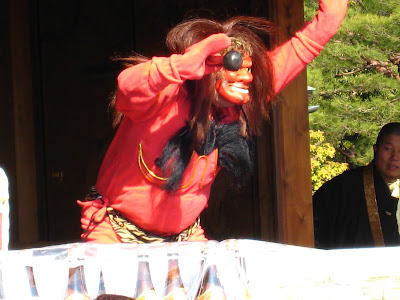[Devil-chasing ceremony at Shogoin Temple, Kyoto (2007)]
In addition, the bean-throwing rite (mamemaki) is performed while shouting "Devils go out, Luck come in" (Oni wa soto, Fuku wa uchi). Afterwards one should eat the same number of beans as one's age to spend the year free from problems. The practice of scattering beans to drive away demons is an example of a traditional magical rite to ward off evil.
In fact, in the past there were four Setsubun dates indicating the change of the seasons. "Setsubun" is the day before the first day of spring, of summer, of autumn and of winter. The first day of the season is - in the same order - called Risshun, Rikka, Risshu and Ritto. But due to the popularity of the Setsubun festival in spring with its magic ceremonies, "Setsubun" afterwards came to be exclusively used for the spring Setsubun.
So today is Risshun, although there is nothing springlike in the air yet...
Bean throwing ceremonies are held at shrines and temples throughout Japan on Setsubun. Unfortunately, yesterday was an overcast and rainy day and as I was busy, too, I did not visit any temple. So here are some pictures from 2007 which I did not have time to post last year!
I took these pictures at Shogoin Temple in Kyoto. Shogoin is a relatively unknown temple (the sweets sold in the neighborhood called Shogoin Yatsuhashi are better known).
[Shogoin Temple, Kyoto]
Shogoin has an interesting origin: when the Retired Emperor Shirakawa made a pilgrimage to the sacred Kumano region in southern Wakayama, the priest Zoyo served as his guide. Out of gratitude, the Emperor later helped Zoyo establish a temple in Kyoto - that was in 1090. The temple was named Shogoin, meaning "Guardian Temple of the Retired Emperor." Zoyo had been a yamabushi, a priest retreating to the mountains for practicing austerities, and the new temple became a yamabushi headquarters in Kyoto - a function it still fulfills.
The association with the imperial family also continued in later ages. When the Imperial Palace was destroyed by fire Shogoin served as a temporary palace. The temple still possesses some art works and personal effects of Emperor Kokaku, and also the Shoin building was formerly part of the palace.
As Shogoin is not a tourist temple, prior consent is needed for visiting - but on Setsubun the grounds are open, as is the Shoin building from which the bean-scattering ceremony is performed.
Oni wa soto, Fuku wa uchi!

